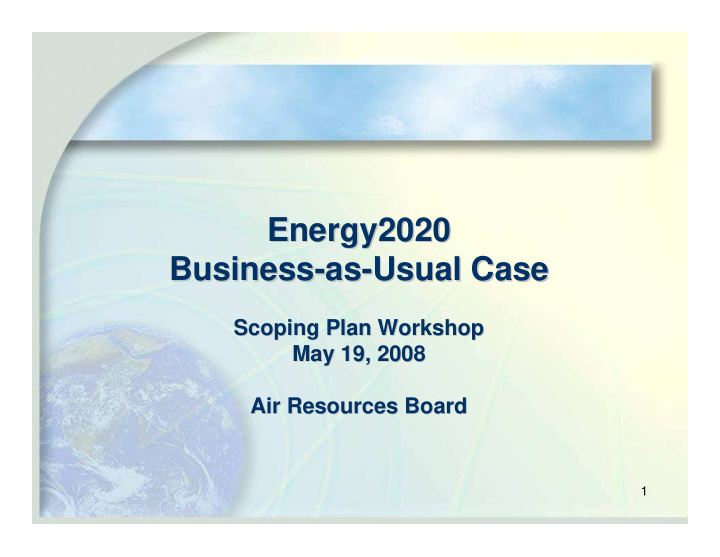



Energy2020 Energy2020 Business- -as as- -Usual Case Usual Case Business Scoping Plan Workshop Scoping Plan Workshop May 19, 2008 May 19, 2008 Air Resources Board Air Resources Board 1
Presentation Outline Presentation Outline 1. Project Background 1. Project Background 2. Description of Energy 2020 2. Description of Energy 2020 3. Description of the Base Case 3. Description of the Base Case 4. Comparison of the Base Case to established data 4. Comparison of the Base Case to established data sources sources 5. Next Steps 5. Next Steps 6. Questions 6. Questions 2
Project Background Project Background • ARB needed the capability to analyze policy options for reducing greenhouse gas emissions. • Model Requirements cover all sectors of the economy • able to model direct measures and flexible compliance mechanisms such as cap • and trade or fees accounts for policy interactions • accounts for GHG emissions and other criteria pollutants • usable in conjunction with a macroeconomic model • ICF/SSI chosen to deliver ARB with a version of the • Energy2020 model. 3
Overview of ENERGY 2020 Overview of ENERGY 2020 • Integrated North American economy, energy and emissions model • Includes all U.S. States and Canada Provinces • Energy demand by sector and end-use • Energy supply for electricity, oil, gas, coal, and other • Separate outputs are provided for each type of air emission: • Greenhouse Gas (CO2, N2O, CH4, SF6, HFC, PFC) • Clean Air Contaminants (SOX, NOX, VOC, CO, PMT, PM10, PM2.5) 4
Overview of the Base Case Overview of the Base Case • The Base Case is a representation of expected GHG emissions under a business-as-usual scenario over 2008-2020. • Policy Cases will be compared with the Base Case to determine the extent to which these policies reduce future emissions. 5
Development of the Base Case Development of the Base Case • The Base Case has been designed so that it is in reasonable agreement with: • Energy Commission 2006 Net System Power Estimate • Energy Commission Statewide California Energy Demand 2008-2018 • ARB GHG Emissions Inventory • EPA Vehicle Efficiency • Differences in definitions make matching exactly difficult. • The remaining slide provide some comparisons between the Energy2020 Base Case and these sources of information 6
Base Case Economic Base Case Economic Ave. Annual Growth Economic Driver 2006-2020 Personal Income 2.8% Gross State Product 3.1% Population 1.2% Coal Price -0.4% World Oil Price -0.7% Natural Gas Wellhead Price -1.4% Passenger VMT 1.2% Freight VMT 1.5% 7
Base Case Generation Output Base Case Generation Output California Energy Energy 2020 Commission Generation Output (GWh/year) 2006 2006 1 Natural Gas/Oil 104,455 106,968 Coal 2,972 17,573 2 Hydro 3 48,114 43,088 Nuclear 31,560 31,959 Other 305 - Renewables 23,164 30,514 Total In-state 210,570 230,102 Imported Electric 81,325 64,763 Total 291,895 294,865 1. 2006 Net System Power Report, Energy Commission Publication # CEC-300-2007-007. 2. Includes electricity generated from several out-of-state coal-fired power plants that are owned by and reported by California utilities. 8 3. Includes existing small Hydro
Base Case Generation Output Base Case Generation Output Ave. Annual Growth Generation Output (GWh/year) 2006-2020 Natural Gas/Oil 0.2% Coal -0.1% Hydro 0.0% Nuclear 0.0% Other 0.0% Renewables 1.6% Total In-state 0.3% Imported Electric 3.2% Total 1.2% 9
Base Case Generation Capacity Base Case Generation Capacity Ave. Annual Growth Generation Capacity (MW) 2006-2020 Natural Gas/Oil 6.2% Coal 0.0% Hydro 0.0% Nuclear 0.0% Other 0.0% Renewables 2.6% Total 4.5% 10
Base Case Electricity Sales Base Case Electricity Sales Ave. Annual Growth 2006-2018 Sales (GWh) Energy2020 CEC Forecast 1 Residential 1.8% 1.8% Commercial 1.4% 1.4% Industrial -0.2% 0.3% Street Lights/Misc. 0.0% 0.9% Total Sales 1.2% 1.3% 1. Form 1.1b – Statewide California Energy Demand 2008-2018 Staff Revised Forecast Electricity Sales by Sector (GWh) 11
Base Case GHG Emissions Base Case GHG Emissions Ave. Annual Ave. Annual Growth Growth 2004-2020 2006-2020 GHG Emissions MMTCO2E ARB Inventory Energy2020 Residential 0.6% 0.9% Commercial 0.8% 1.0% Industrial 0.4% 1.7% Power Sector 1.2% 1.5% Transportation 1.6% 1.1% Waste and Wastewater 1.7% 1.7% Unknown 1 6.1% - Total 1.5% 1.3% 1. Unknown include fuel use that is not mapped to a specific sector or Ozone Depleting Substance 12 Substitutes. These emissions are accounted for in the individual Energy2020 sectors.
Next Steps Next Steps • Continued refinement of the mapping between the ARB emissions inventory and Energy2020. • Better accounting of imported electricity and emissions. • Refinement of Device and Process Efficiency Investment amounts. • Modeling policy cases • Macroeconomic analysis 13
Questions and Comments? Questions and Comments? Questions and Comments? E- -mail questions to CCPlan@arb.ca.gov mail questions to CCPlan@arb.ca.gov E E-mail questions to CCPlan@arb.ca.gov 14
Recommend
More recommend